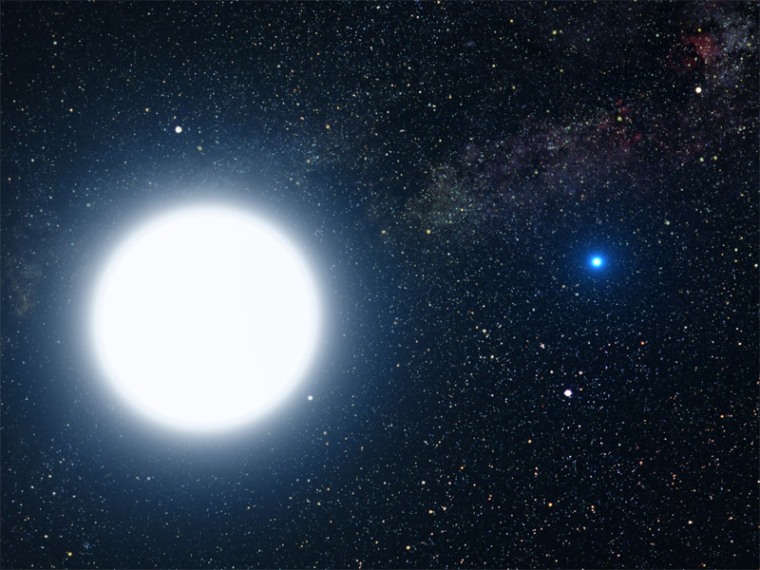In our continuing mission to explore strange new worlds, to seek out the potential for alien life and look for signals from extraterrestrial civilizations,* scientists are getting more and more creative when exploring new star systems they might have otherwise overlooked.
Enter the white dwarf: the "dead" remnant of a sunlike star that ate its entire supply of hydrogen, ultimately puffing up into a violent red giant, leaving a tiny sparkling jewel behind. This tiny, Earth-sized sparkling remnant is called a white dwarf, and in about 4 billion to 5 billion years, that's what our sun will look like.
According to Eric Agol from the University of Washington, perhaps we shouldn't discount white dwarfs from exoplanet studies. If the conditions are right, these tiny stellar objects could provide just enough heat to support their own habitable zones (i.e., a region surrounding the star where water existing on a planetary surface could be maintained in a liquid state).
So far, most studies of exoplanetary systems have focused on sunlike stars, or star systems where the exoplanets are really big or orbit very close to their host star so they can be detected. White dwarfs, on the other hand, have been largely overlooked as they are small and not thought to possess viable life-giving planetary systems.
White dwarfs, despite their seemingly peaceful nature, are actually the result of some seriously violent star death. Although we're not talking about the explosive ferocity of a supernova (these stars are too small to ignite a supernova), when stars like our sun enter the red giant phase, their surfaces balloon up, engulfing any nearby planets.
For example, it is predicted that our sun will swell out to beyond the orbit of Earth when it dies. While a swelling sun, expanding to fill our sky, might make for an impressive sight for anyone (or anything) living on Earth in the 40 millionth century A.D., Earth will be toast.
It is also predicted that as the sun violently sheds its outer layers, vast quantities of mass will be hurled into space, causing the remaining planets to spiral deeper into space, away from the dying sun.
This is the key reason why white dwarfs are often alone, living for billions of years without any signs of a planetary system — the planets are either lost, destroyed or promoted to orbits many times further away from the star.
Life-Giving Dwarfs?
But say if, after all this star death has calmed down, planetary formation occurs near a white dwarf, or a passing planet is "stolen" from another system? Although there may well be a white dwarf planet-forming mechanism, or a planet may be plucked from somewhere else, for the planet to orbit within the white dwarf's "habitable zone," according to Agol, this Earth-like world would need to orbit very close to the white dwarf.
According to his calculations, the habitable zone will be 0.005 to 0.02 AU from the white dwarf — that's 50 to 200 times closer to the white dwarf as the Earth is to the sun. It is therefore very likely that this hypothetical world will be "tidally locked" with the white dwarf; one side of the world will be in continuous daylight.
There are obvious shortfalls to the idea of habitable planets orbiting white dwarfs, but there are also huge strengths. White dwarfs can live for billions of years. In fact, they can have lifetimes comparable with that of the lifetime of our universe. Also, there are lots of white dwarfs out there. About 5 percent of all stars are white dwarfs. We also know that many white dwarfs possess dusty disks, possibly indicating planetary formation.
Although little theoretical work has been done on the physics behind white dwarf planetary systems, just by looking at the numbers, there's statistical reasons to think there might be a few planets that orbit their white dwarf parents within the habitable zones.
Agol suggests that exoplanet surveys should be extended to search for worlds orbiting white dwarfs, as they are so compact (with dimensions comparable to Earth), when their orbiting planetary companion crosses (or transits) the star when seen from Earth, the light from the white dwarf may be blocked all together. Searching for blinking white dwarfs could therefore be an exciting study.
Ancient Aliens?
Another thing to consider is that as white dwarfs are long-living stellar remnants, they could provide a steady, long-term energy source for alien life. Perhaps life can be nurtured and allowed to develop long-term, ensuring the development of an alien civilization that can persist for billions of years without the concern of their star dying any time soon.
White dwarfs are not sustained via nuclear fusion (like our sun), but they are so dense that they are supported by the quantum pressure of the Pauli exclusion principal, and slowly radiate the heat from the original star. Although eventually the star will radiate the majority of the leftover heat, causing the habitable zone to shrink, perhaps a hypothetical ancient alien race will have the technology to move to another star.
However, talk of ancient alien races is more speculative than hypothetical white dwarf planetary systems ... but it's an interesting thought.
*Yes, this is a bastardized version of the Star Trek intro as voiced by the legendary William Shatner (who turned 80 this week, by the way), so in a round-about way, this article is inspired by the original Captain Kirk. I'm a geek. That is all.
Publication: Transit surveys for Earths in the habitable zones of white dwarfs, Eric Agol, 2011. arXiv:1103.2791v1 [astro-ph.EP]
